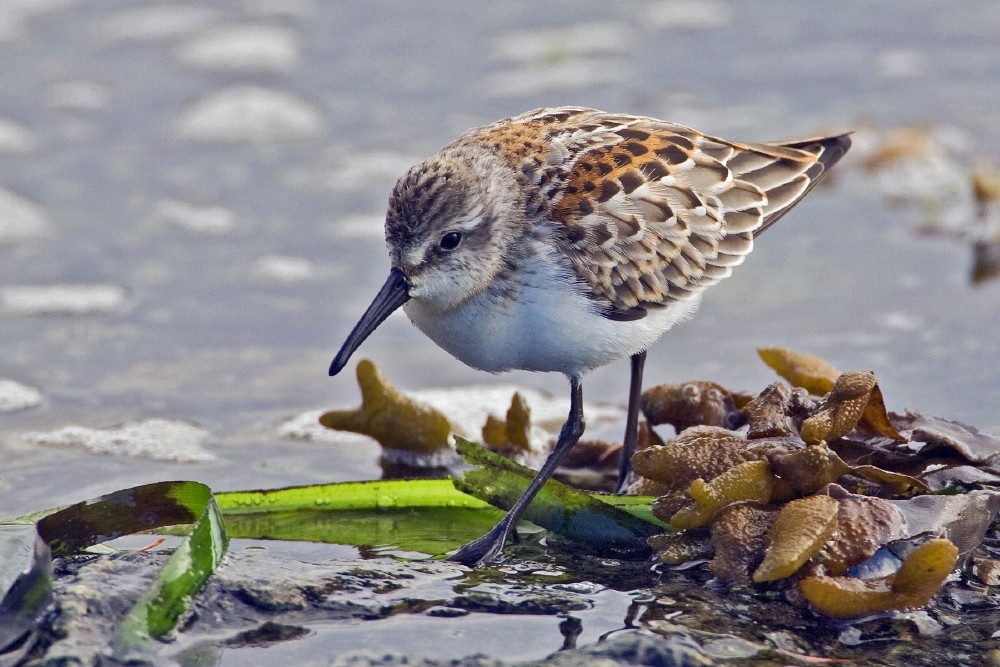Western Sandpiper
A species of Calidris Scientific name : Calidris mauri Genus : Calidris
Western Sandpiper, A species of Calidris
Botanical name: Calidris mauri
Genus: Calidris
 Photo By Alan D. Wilson , used under CC-BY-SA-3.0 /Cropped and compressed from original
Photo By Alan D. Wilson , used under CC-BY-SA-3.0 /Cropped and compressed from original Description
Adults have dark legs and a short, thin, dark bill, thinner at the tip. The body is brown on top and white underneath. They are reddish-brown on the crown. This bird can be difficult to distinguish from other similar tiny shorebirds, especially the semipalmated sandpiper. This is particularly the case in winter plumage, when both species are plain gray. The western sandpiper acquires winter plumage much earlier in the autumn than the semipalmated sandpiper. Measurements: Length: 5.5-6.7 in (14-17 cm) Weight: 0.8-1.2 oz (22-35 g) Wingspan: 13.8-14.6 in (35-37 cm) 
Size
15-18 cm (6-7 in)
Colors
Brown
Black
Gray
White
Life Expectancy
9 years
Nest Placement
Ground
Clutch Size
2 - 4 eggs
Incubation Period
1 brood
Feeding Habits
Western Sandpiper consume insects, spiders, and aquatic invertebrates, with seasonal diet variation. They forage in shallow water, using probing and visual hunting methods, with sexual dimorphism in feeding technique and prey size due to females’ longer bills. Diet includes biofilm, insects, larvae, crustaceans, mollusks, and worms.
Habitat
Western Sandpiper mainly resides in coastal and inland wetlands, including shores and mudflats, and prefer tundra regions for breeding. Habitats vary from shallow coastal lagoons to river deltas and tidal estuaries with fine mud. During migration, they utilize various wetlands, and in winter, they also occupy salt evaporation ponds and occasionally high-altitude Mexican lakes.
Nest Behavior
The male western Sandpiper prepares, the female selects the nest site. Together they arrange the lining. Western Sandpiper exhibits precise nesting timing and both parents share in egg and young care.
Nest Characteristics
Western Sandpiper's nests are shallow depressions in dry tundra, lined with willow leaves, birch, grasses, sedges, lichens, often under grass tussocks or dwarf birch. The interior cup is about 2.5 inches across and 2.2 inches deep.
Dite type
Aquatic invertebrate eater
Migration Overview
They migrate to both coasts of North America and South America, as well as the Caribbean. It is a very rare vagrant to western Europe. 
General Info
Feeding Habits
Bird food type
Sounds
Song
Recording location: United States
Behavior
Western Sandpiper start their breeding season with males arriving first, where they contend with harsh conditions while carving out territories with distinct display flights, excluding a hovering display, contrasting with other sandpiper species. These territorial birds aggressively defend their grounds from intruders, including other males and various shorebirds. Courting involves a ritual of displays and calls, leading to monogamous pairings, though occasional infidelity is noted. Pairs share incubation duties, but females leave before offspring fledge, entrusting males with chick-rearing. Outside breeding seasons, western Sandpiper establish feeding territories and display lesser aggression compared to counterparts, maintaining order within their habitat.
Species Status
Not globally threatened.
Scientific Classification
Phylum
Chordates Class
Birds Order
Shorebirds Family
Sandpipers Genus
Calidris Species
Western Sandpiper